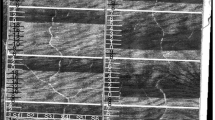Abstract
Agriculture has long been promoted as a prime beneficiary of remotely sensed data and satellite data are now routinely used in crop production forecasts and for resource surveys. However the potential for using satellite data for irrigation management has not been realized. An experiment was conducted at the Maricopa Agricultural Center, Arizona, to test the feasibility of using satellite and aircraft data for crop monitoring and irrigation management. This experiment identified several shortcomings of present satellite systems with respect to providing timely information for irrigation management. On the other hand, a preliminary evaluation of aircraft data showed some potential for application to irrigation scheduling. A simple cost/benefit analysis suggested that profits could be achieved through the communal use of remotely sensed information from both satellites and aircraft in moderate-size irrigation districts.
Similar content being viewed by others
References
Bausch WC (1989) Computerized irrigation scheduling using spectral feedback. In: Dood VA, Grace PM (eds) Proc 11th Intl Cong on Agric Engineering. AA Balkema Publishers, Rotterdam, The Netherlands 1:561–568
Bausch WC, Neale CMU (1989) Spectral inputs improve corn crop coefficients and irrigation scheduling. Trans ASAE 32:1901–1908
Clothier BE, Clawson KL, Pinter PJ Jr, Moran MS, Reginato RJ, Jackson RD (1986) Estimation of soil heat flux from net radiation during the growth of alfalfa. Agric For Meteorol 37:319–329
Deering DW, Rouse JW Jr, Haas RH, Schell HH (1975) Measuring “forage production” of grazing units from Landsat MSS data. Proc 10th Intl Symp of Rem Sens Environ, ERIM, Ann Arbor, Michigan, pp 1169–1198
Gellman DI, Biggar SF, Thome KJ, Slater PN, Moran MS, Dinguirard M, Henry P (1993) A review of SPOT-1 and -2 calibrations at White Sands from launch to present. Proc Soc of Photo-Optical Instrum Eng Symp, 12–16 April, Orlando, Fl, pp 118–125
Holm RG, Moran MS, Jackson RD, Slater PN, Yuan B, Biggar SF (1989) Surface reflectance factor retrieval from Thematic Mapper data. Rem Sens Environ 27:47–57
Huete AR (1988) A soil-adjusted vegetation index (SAVI). Rem Sens Environ 25:89–105
Husman SH, Garrot DJ Jr, Moore M (1991) Water stress effects on Upland Cotton lint yields using infrared thermometry to schedule irrigations. Cotton Report, College of Agriculture, University of Arizona, Tucson, Arizona, Series P-87:111–113
Jackson RD (1984) Remote sensing of vegetation characteristics for farm management. SPIE Rem Sens 475:81–96
Jackson RD, Idso SB, Reginato RJ, Pinter PJ Jr (1981) Canopy temperature as a crop water stress indicator. Water Resour Res 17: 1133–1138
Maas SJ, Moran MS, Jackson RD (1992) Combining remote sensing and modeling for regional resource monitoring, Part II: A simple model for estimating surface evaporation and biomass production. ASPRS/ACSM/RT'92 Convention: Mapping and Monitoring Global Change, 3–8 August, Washington, DC, pp 225–234
Moran MS, Clarke TR, Inoue Y, Vidal A (1994) Estimating crop water deficit using the relation between surface-air temperature and spectral vegetation index. Rem Sens Environ (in press)
Moran MS, Jackson RD, Hart GF, Slater PN, Bartell RJ, Biggar SF, Gellman DI, Santer RP (1990) Obtaining surface reflectance factors from atmospheric and view angle corrected SPOT-1 HRV data. Rem Sens Environ 32:203–214
Moran MS, Jackson RD, Slater PN, Teillet PM (1992) Evaluation of simplified procedures for retrieval of land surface reflectance factors from satellite sensor output. Rem Sens Environ 41: 169–184
Park AB, Colwell RN, Meyers VF (1968) Resource survey by satellite; science fiction coming true. Yearbook of Agriculture, pp13–19
Pinter PJ Jr, Jackson RD, Moran MS (1990) Bidirectional reflectance factors of agricultural targets: a comparison of ground-, aircraftand satellite-based observations. Rem Sens Environ 32:215–228
Qi J, Huete AR, Moran MS, Chehbouni A, Jackson RD (1993) Interpretation of vegetation indices derived from multitemporal SPOT images. Rem Sens Environ 44:89–101
Thome KJ, Gellman DI, Parada RJ, Biggar SF, Slater PN, Moran MS (1993) In-flight radiometric calibration of Landsat-5 Thematic Mapper from 1984 to present. Proc Soc of Photo-Optical Instrum Eng Symp, 12–16 April, Orlando, Fl, pp 126–130
Author information
Authors and Affiliations
Rights and permissions
About this article
Cite this article
Moran, M.S. Irrigation management in Arizona using satellites and airplanes. Irrig Sci 15, 35–44 (1994). https://doi.org/10.1007/BF00187793
Received:
Issue Date:
DOI: https://doi.org/10.1007/BF00187793




